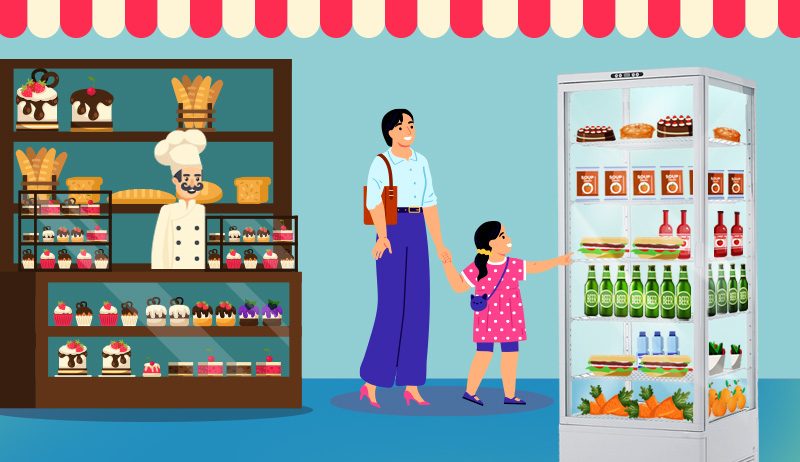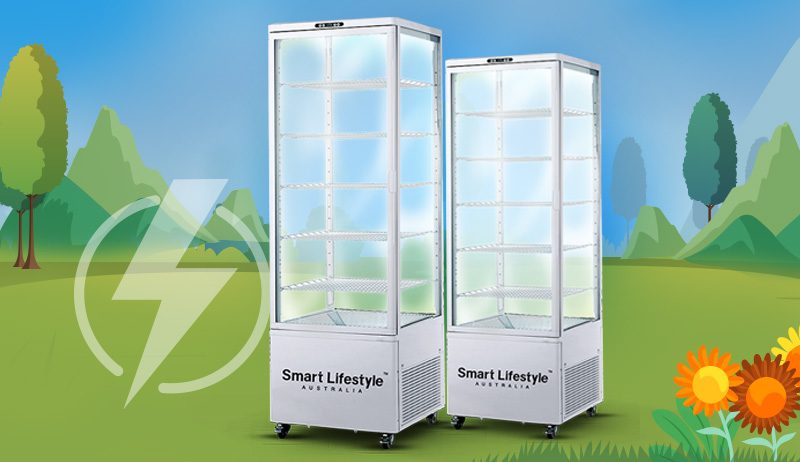How To Maximizing Sales and Minimizing Waste with RDCs
Strategic Product Placement
- Eye-Level Display: Place high-demand or visually appealing food products at eye level to catch customers’ attention first.
- Group Similar Items: Arrange products in clusters, making it easier for customers to find related items. For example, place various flavors of yogurt together.
- Cross-Promotion: Pair complementary items, such as placing freshly baked bread near the deli section or beverages near sandwiches.

Fresh and Appealing Presentation
- Well-Lit Display: Ensure adequate lighting within the RDC to make products look vibrant and appealing.
- Color Coordination: Arrange products with contrasting colors for a visually striking display.
- Regular Restocking: Maintain a well-stocked display to avoid empty spaces, which can discourage customers from purchasing.
Temperature Management
- Optimal Cooling: Set the RDC to the appropriate temperature for the products on display to ensure freshness and compliance with food safety regulations.
Promotions and Special Offers
- Highlight Promotions: Use RDCs to showcase products on sale or offer bundled deals to encourage larger purchases.
- Limited-Time Offers: Create a sense of urgency by promoting time-sensitive offers or seasonal items.
Data-Driven Decision Making
- Smart RDCs: Invest in smart RDCs that collect data on temperature, usage patterns, and popular products. Analyze this data to optimize inventory and product placement. Check out Smart Lifestyle Australia.
- Sales Reports: Regularly review sales reports to identify top-selling items and adjust your RDC accordingly.
Inventory Rotation
- First In, First Out (FIFO): Arrange products based on the FIFO principle to prevent older items from going unsold.
- Seasonal Rotation: Rotate products based on seasons to ensure that fresh and relevant items are always on display.
Employee Training
- Product Knowledge: Train staff to have a good understanding of the products on display so they can provide recommendations and answer customer questions.
- Restocking Routine: Establish a routine for staff to check and restock the RDC to maintain an appealing appearance.

Reduce Packaging
- Pre-Packaged Portions: Offer pre-packaged portions of items to reduce the risk of contamination and minimize waste from handling.
Eco-Friendly Practices
- Reusable Packaging: Encourage customers to bring their own reusable containers for items like salads or deli items.
- Donation or Discount: Consider donating unsold but still safe-to-consume items to local charities or offering discounts near closing time.
Customer Engagement
- Sampling: Offer samples of items to encourage customers to try new products.
- Interactive Labels: Use labels that provide additional information, such as nutritional content or recipe ideas, to engage customers.
Regular Maintenance
- Cleanliness: Keep the RDC clean and free of spills to maintain an inviting display.
- Temperature Checks: Regularly monitor and record the RDC’s temperature to ensure it’s within the optimal range.
Refrigerated Display Cabinets (RDCs) are the champions of energy efficiency in the world of retail. Think of them as the cool operators that balance showcasing products while being kind to the environment. These cabinets use smart cooling techniques and modern technology to keep products at the perfect temperature without gobbling up excess energy. This not only helps businesses cut down on their energy bills but also contributes to a greener planet by reducing electricity usage. So, next time you spot those well-lit and chilled displays in stores, you’ll know that RDCs are the unsung heroes that keep things fresh without breaking the bank or harming the Earth.
What is The Purpose of a Refrigerated Display Cabinet
The primary purpose of a display chiller, also known as a refrigerated display cabinet or showcase, is to showcase and preserve perishable goods in a controlled and visually appealing environment. Display refrigerators are commonly used in various retail and foodservice establishments, such as supermarkets, delis, bakeries, cafes, and restaurants. They serve several important purposes:
- Preservation of Freshness: Energy efficient refrigerated display cases are equipped with cooling systems that maintain consistent low temperatures, preventing the growth of bacteria and spoilage of perishable items. This helps keep products like dairy, meats, salads, desserts, and beverages fresh for a longer period, reducing waste and ensuring customers receive high-quality goods.
- Product Visibility and Presentation: Display refrigerators are designed with transparent glass panels that offer customers a clear view of the products inside. This enhances the visual appeal of the products and encourages customers to make purchase decisions based on the freshness and presentation of the items.
- Enticing Presentation: Display refrigerators often come with interior lighting that illuminates the products, creating an enticing and eye-catching display. Well-lit products look more appealing and appetizing, which can lead to increased sales and customer satisfaction.

- Organization and Accessibility: The adjustable shelves and well-thought-out layout of display refrigerators enable efficient organization of products. Businesses can easily categorize and arrange items based on their types, sizes, or temperature requirements. This organization makes it easier for customers to navigate and locate the products they’re interested in.
- Impulse Purchases: The attractive presentation of products in a display chiller can trigger impulse purchases. As customers see items that look tempting, they’re more likely to add extra items to their shopping basket, leading to increased sales for businesses.
- Customized Temperature Zones: Many display refrigerators have multiple compartments with different temperature zones. This allows businesses to store a variety of products in the same unit while maintaining each product’s ideal temperature. For example, a bakery might use one section for cakes and another for pastries.
- Efficient Use of Space: Display refrigerators maximize the use of space within a retail environment. They offer vertical shelving and often have a relatively small footprint, allowing businesses to display a wide variety of products without taking up excessive floor space.
- Hygiene and Food Safety: Modern display refrigerators are designed with hygiene and food safety in mind. Removable shelves, easy-to-clean surfaces, and features like anti-condensation technology contribute to maintaining a clean and safe environment for products.
- Branding and Marketing: Display refrigerators provide businesses with an opportunity to showcase their branding and marketing materials. Displaying logos, branding elements, and signage within the chiller can reinforce the business’s identity and communicate promotional messages.
Incorporating Refrigerated Display Cabinets (RDCs) isn’t just a decision; it’s a strategic investment that revolutionizes your product presentation and operations. From captivating displays that engage customers to efficient inventory management that curbs waste, RDCs offer undeniable advantages.
Take the leap toward fresher, visually appealing displays that beckon customers to explore and purchase. The time is now; choose growth and excellence. Invest in Refrigerated Display Cabinets to propel your business toward heightened sales and reduced waste. Your journey to retail excellence starts today.







